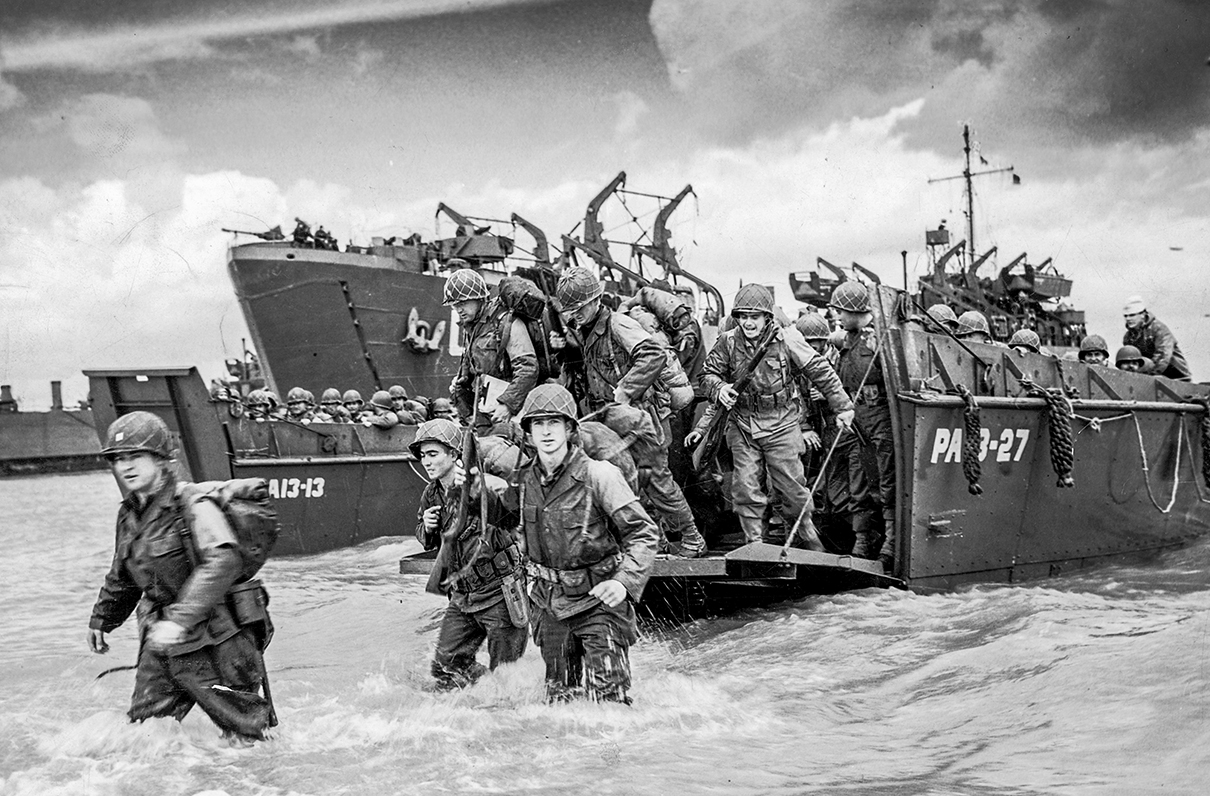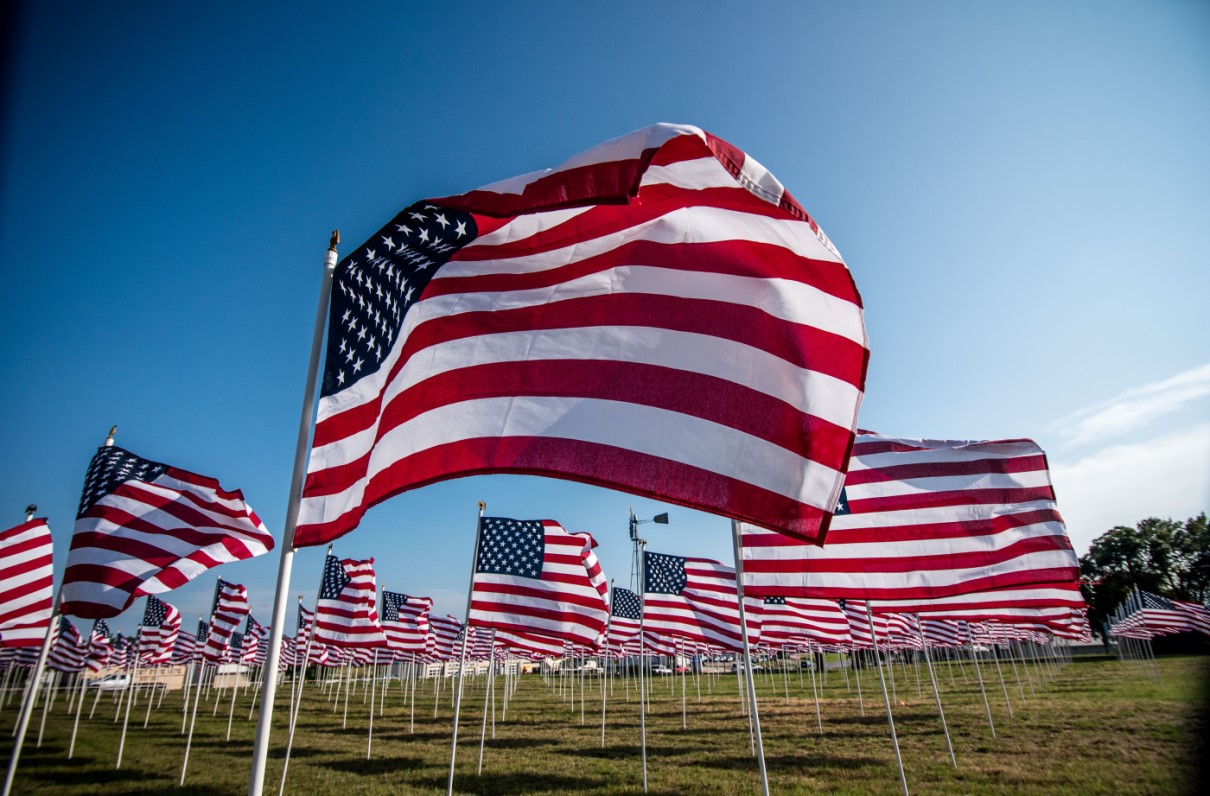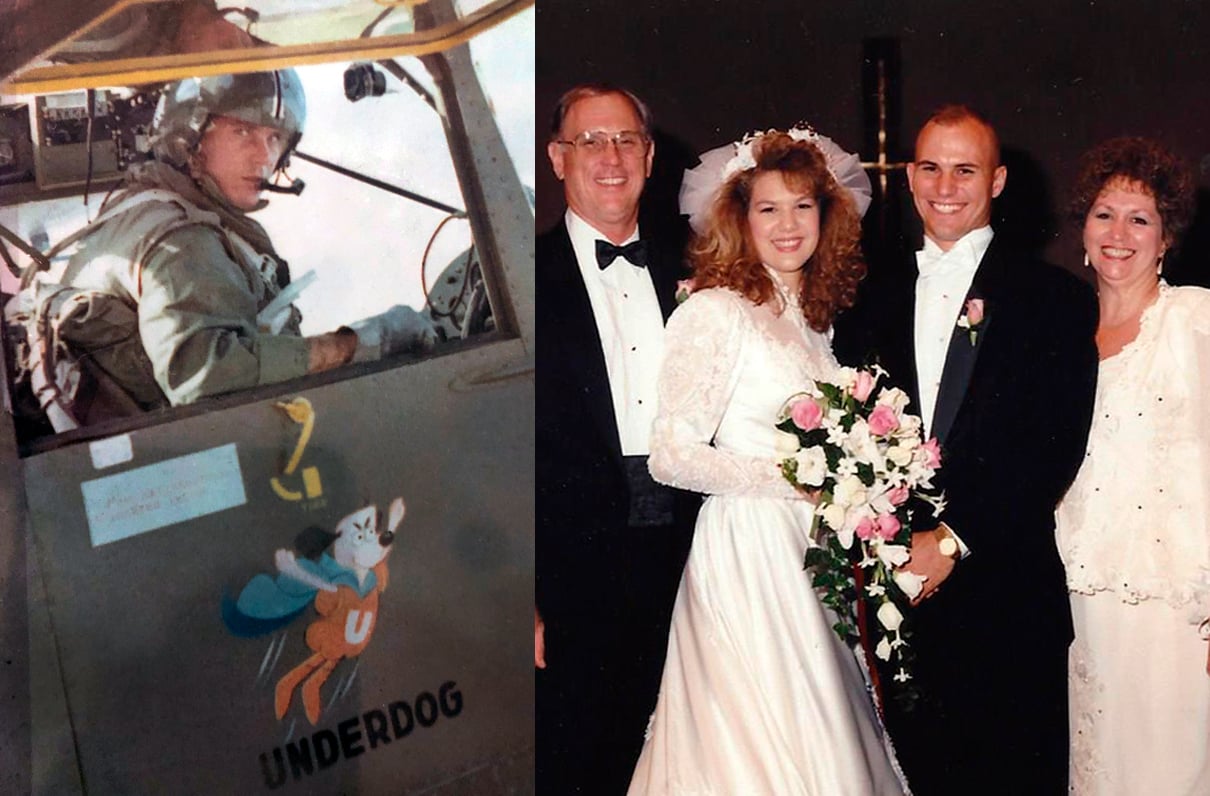During the first terrifying thirty or so minutes of the 1998 film, Saving Private Ryan, the audience is spell-bound as they watch Tom Hanks as Captain Miller of Charlie Company, 2nd Ranger Battalion approaching in a “Higgins” boat and landing on the Dog-Green section of Omaha Beach during the invasion of Normandy on D-Day, 6 June 1944, and assaulting fortified German defenses under murderous fire. Although the opening sequence and details are historically accurate in some respects, the actual events of C Company after landing are much more amazing and heroic than the scenes portrayed in the film.
The real commander of C Company, 2nd Ranger Battalion on D-Day was 24-year-old Capt. Ralph E. Goranson. His company did not land on the Dog-Green section of Omaha Beach as portrayed in the film but several yards to the right or west of Dog-Green on Charlie section. Soldiers of the 116th Infantry Regiment, 29th Infantry Division landed on Dog-Green.
Consisting of 68 Rangers, C Company sailed from England to the Normandy beachhead aboard the British ship Prince Charles. The Rangers were divided into three groups. Force A consisted of three Ranger companies with the mission of scaling Pointe du Hoc four miles westward along the Normandy coast and attacking the German artillery position there. Force B was C Company, 2nd Ranger Battalion whose mission was defeat of the German defenses at Pointe de la Percée on the far right of Omaha Beach. Force C consisted of the 5th Ranger Battalion plus two 2nd Ranger Battalion companies with a mission to follow up the success of the Pointe du Hoc attack.
None of the Rangers on D-Day were in U.S. LCVP (Landing Craft, Vehicles & Personnel) - “Higgins” boats - but in British Royal Navy LCAs (Landing Craft, Attack) with Royal Navy crews. The LCA was a British designed landing craft with a four man crew and capable of carrying 37 troop passengers. Unlike the “Higgins” LCVP, the LCA had armored bulkheads, sides and a decked-over troop well. Goranson would later praise the Royal Navy crewmen who “beached us on time in the best place, exactly per our instructions,” according to video footage narrated by Navy Cmdr. Charles E. Robison. In one of the two Royal Navy LCAs transporting Company C to the beach, Ranger Sgt. Walter Geldon was celebrating his third wedding anniversary and the men in his boat were singing in his honor. Geldon was one of many who would die on the beach that morning.
The German defenses consisted of fifteen semi-independent strongpoints (Widerstandsnest, or WN) numbered consecutively WN60 to WN74 from east to west. These strongpoints included concrete structures and pillboxes with various caliber field and anti-tank guns. They were sited with interlocking fields of fire and reinforced with belts of barbwire and infantry trenches. The sturdiest pillboxes were generally built directly in or immediately adjacent to the five beach exits.
Vierville draw, the western most exit off the beach near where Company C would land, was defended by three such strongpoints - WN 71 above the eastern side of the draw, and WN 72 and WN 73 on the western side.
Just past the Vierville draw, the beach narrowed along side a stretch of cliffs higher than 100 feet that extended all the way to Pointe de la Percée to the west where it abruptly terminated. At high tide, there was no beach save for a belt of boulders only a few feet wide. Cloud cover prevented bombers from bombing close-in prior to the landing and they released their bombs too late to hit anything near Omaha beach. The problem was further exacerbated by failure to provide adequate naval gunfire, the best means of destruction of beach defenses, to achieve the desired effect. The result was the sustainment of heavy casualties among the landing forces and the near-failure of the Omaha operation.
Lt. Col James Rudder, commander of 2nd Ranger Battalion, told Goranson in May before the attack, “you have the toughest goddamn job on the whole beach.”
Capt. Goranson had devised two different attack plans, depending upon the situation when they landed. Provided troops of the 29th Infantry Division to the immediate left of section Charlie were able to clear Vierville draw, he would execute his “Plan One” and Company C would move inland through the draw after landing. The 2nd Ranger Battalion would then move west along the coast road and attack the enemy strongpoint at Pointe de la Percée, before continuing on to Pointe du Hoc. However, if the Vierville draw had not been cleared, Goranson would initiate his “Plan Two,” a much more challenging scheme requiring the Rangers to ascend the sheer cliffs overlooking Charlie sector prior to moving inland. Even if only a few Germans had survived the planned pre-invasion bombardment and could resist the Rangers from the clifftop, Plan Two would be extraordinarily difficult to execute, especially as Goranson’s men lacked most of the specialized climbing gear that their fellow Rangers would employ at Pointe du Hoc.
By first light of dawn, the two LCAs carrying the 68 Rangers of Charlie Company reached the beach at 6:45 a.m. By that time, they came under fire from German artillery, mortars and small arms. As Goranson’s LCA landed, it was hit by four artillery rounds At least twelve Rangers in his LCA were killed, most of the rest were wounded, and not a single Ranger was yet on Omaha Beach.
On the second LCA carrying 37 Rangers, Second Platoon leader Lt. Sidney Salomon could hear the sharp, pinging of machine-gun bullets hitting the side of his LCA. When the LCA landed, Lt. Salomon was the first off the ramp, but Sgt. Oliver Reed, who followed Salomon, was immediately felled by machine-gun fire. As the rest of the boat team exited the LCA, Salomon grabbed Reed’s collar and dragged him through waist-deep surf on to dry sand. After going a short distance, a mortar shell landed behind Lt. Salomon, knocking him forward and on the ground. German machine gun fire was kicking up sand around him as he rose and ran to the base of the cliff.
Burdened by equipment and waterlogged uniforms, the Rangers found it hard to move swiftly across the soft sand, and German Forces cut many of them down.1st Sgt. Henry “Steve” Golas, seeing men cringing under the fire, shouted “Get your ass off this beach!” and then moved forward only to be killed by machine-gun fire. Thirteen more Rangers were seriously wounded, crossing the almost 300 yards of exposed beach at low tide. Those who survived kept moving while the wounded crawled behind them. T/5 Jesse Runyan, a BAR gunner, was shot in the groin and lost the use of his legs. Despite his wounds, Runyan continued crawling forward with his weapon, firing as he went. He was awarded the Silver Star for his action.
In front of the Vierville Draw off to his left, Goranson saw tanks and 29th Division troops receiving even heavier enemy fire. Nineteen Rangers were killed on this part of the beach. The best course of action was obvious - “Plan Two”. Although reduced to about thirty men, the Rangers would climb the cliff. First Platoon leader Lt. William Moody, Sgt. Julius Belcher, and Pfc. Otto Stephens followed the cliff base westward for about 300 yards and found a section of cliff to ascend. Stephens climbed the 100-foot cliff first, thrusting his bayonet into the cliff face to gain successive hand holds. Belcher and Moody followed and brought up four sections of toggle rope to anchor on the cliff top, for following Rangers. The ascent of the cliff would not be easy, but those Rangers still capable of climbing it slipped westward along the cliff base to follow the first three men up. Without waiting for his others to reach the top, Stephens proceeded to attack the enemy positions located there.
As later events would prove, this movement passed WN 73 defensive position at the clifftop allowing the Rangers to make the strenuous climb without interference. Charlie Company may have been the first assault unit to reach the high ground above Omaha Beach. More Rangers climbed the cliff and joined those at the top. Goranson climbed at 7:15 a.m., and decided the situation in front of the Vierville draw required immediate action, and turned his diminishing force east to attack the fortified house and surrounding trenches rather than move westward to eliminate WN74 at Pointe de la Percée.
Attacking WN 73 would be a tough job. WN 73 was located on the high bluff on the right side of the Vierville draw and consisted of several stone buildings as well as zigzag trenches, heavily fortified fighting positions and dugouts, and a well camouflaged concrete pillbox housing a 75mm PAK 97/38 gun in the side of the bluff. The pillbox’s aperture faced east, making it nearly invisible when viewed from the sea, with a field of fire straight down the entire beach.
There was a large stone house built in a small nook in the cliff face. A stone barn-like building stood behind the house on one of Omaha’s highest spots. Moody and Stephens advanced eastward along the cliff edge toward the house and quickly saw that the Germans there were focused on killing the U.S. soldiers landing in front of the Vierville draw. The house was destroyed by naval gunfire, but German troops still occupied the trenches on the far side of the building. The Rangers moved past the house in search of Germans lurking somewhere in the dugouts and trenches in this strongpoint. Goranson’s meager force, however, could do little more than probe the enemy position and engage the defenders. Lt. Salomon, who had managed to climb the cliff despite a wound he suffered on the beach, was one of the first Rangers to enter the maze of trenches on the far side of the house. Only nine men of his platoon got to the top of the cliff.
A sniper killed Lt. Moody. Salomon, Stephens and other Rangers continued to clear trenches and dugouts using grenades and small arms. They remained on top for the rest of the day, as the enemy was apparently driven back inland. Although the surviving Rangers were too few to completely overrun the strongpoint, Goranson opted to hold the ground already gained and continue engagingGerman troops in the trenches. As the Rangers in the trench began to pass the house and barn, the German forces threw grenades at the Rangers and the Rangers threw the grenades back. Belcher inched up to the trench-edge, and encountered a German who ducked into a dugout. Belcher and another Ranger entered the trench and killed three Germans near the mortar emplacement.
Goranson led an attack to clear the stone house and his Rangers began to clear trenches, mortar pits, and machine-gun nests in the vicinity. They were eventually joined by about twenty infantrymen from the 29th Division, who had climbed the cliff. As more German troops came from Vierville to reinforce the WN 73 strongpoint, Company C remained through the early afternoon killing Germans. Later, as the fighting subsided, Goranson led a patrol to Pointe-de-la- Percée around 1400 hours, but as they were approaching, the site was destroyed by US Navy destroyer fire. In the late afternoon, Company C headed toward Pointe du Hoc.
Unlike Tom Hanks’ Captain Miller of Saving Private Ryan, Ralph Goranson led Charlie Company, 2nd Ranger Battalion through the rest of the war and lived a long and productive life before passing away on November 14, 2012 at age 93.
Sources:
Robert W. Black, The Battalion: The Dramatic Story of the 2nd Ranger Battalion in World War II
William O, Darby, Darby’s Rangers: We Led the Way
Steven J. Zaloga, Rangers Lead The Way: Pointe-du-Hoc D-Day 1944
Steven J. Zaloga, The Devil’s Garden: Rommel’s Desperate Defense of Omaha Beach on D-Day
Joseph Balkoski, Omaha Beach: D-Day, June 6, 1944
All quotes are from Balkoski, Omaha Beach
Major Homer Hodge, US Army Retired, is an independent historian specializing in the US military in World War II. He has an MA in Military History and a PhD in International Relations and 30 years experience doing research and reporting in intelligence.


